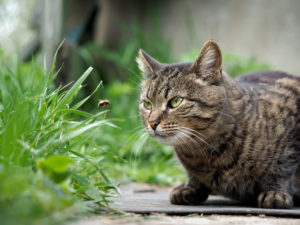
Learning in advance how to treat a cat bee sting can save you time and money. Of course, advance preparation can also offer your kitty immediate comfort in the unfortunate event that she is ever stung. As the temperature continues to rise outside, so will your cat’s curiosity about the new scents and colors bursting around her. It’s this sort of curiosity, however, that often leads to painfully unexpected meeting with a busy bee! Here are our best tips on how to effectively treat a cat who has been stung.

How Serious Is a Cat Bee Sting?
In most instances, a cat bee sting isn’t that serious. Painful, yes, but not life threatening. Just like humans, however, your cat may be allergic to bee venom and, if this is the case, do not delay taking your cat to the veterinarian for immediate emergency care. While most will only experience soft-tissue swelling and pain at the site of the sting, some cats may experience more severe symptoms such as:
- Vomiting
- Diarrhea
- Loss of consciousness
- Anaphylactic shock
Again, if you suspect that your kitty is having an allergic reaction to a cat bee sting, do not hesitate to visit an emergency veterinarian right away!

How to Treat a Cat Bee Sting at Home
When pets are stung by a bee, the most telltale symptoms include swelling and tenderness at the location of the sting. Usually, these symptoms appear on the face due to a curious cat moving in on a bee for a closer inspection. A sting may also occur on the paws as a result of swatting a bee away or even accidentally stepping on one while walking outdoors. As soon as you notice the symptoms and are able to identify where the cat bee sting is centered, it’s time to spring into quick action by following these steps:
- Try to scrape the stinger out with a credit card or a similar object (do not try to pull the stinger out with your fingers or a tweezer as you risk breaking the venom sack and causing more of the toxin to spread throughout your cat’s body).
- Apply a cold, wet washcloth to the area of the sting to help soothe it and reduce the swelling.
- Call your veterinarian for further care instructions.
Some cat owners report success in using Benadryl to treat the pain and swelling that follows a cat bee sting. We cannot recommend that you try this, however, as it is illegal for us–or even your vet–to advise you to use an over the counter medication to treat a cat bee sting. Benadryl is only approved for human use and, while many report success with using it, an incorrect dosage might make your cat sick.

How Do You Treat Bee Stings?
Do you have experience treating a cat bee sting? What do you want to add to our advice? Please remember to share this post with all of the cat lovers in your life and spread the news about treating bee stings in pets on social media. Use the #fetchpetcare hash and we’ll gladly meet you there, too!
Source: Read Full Article